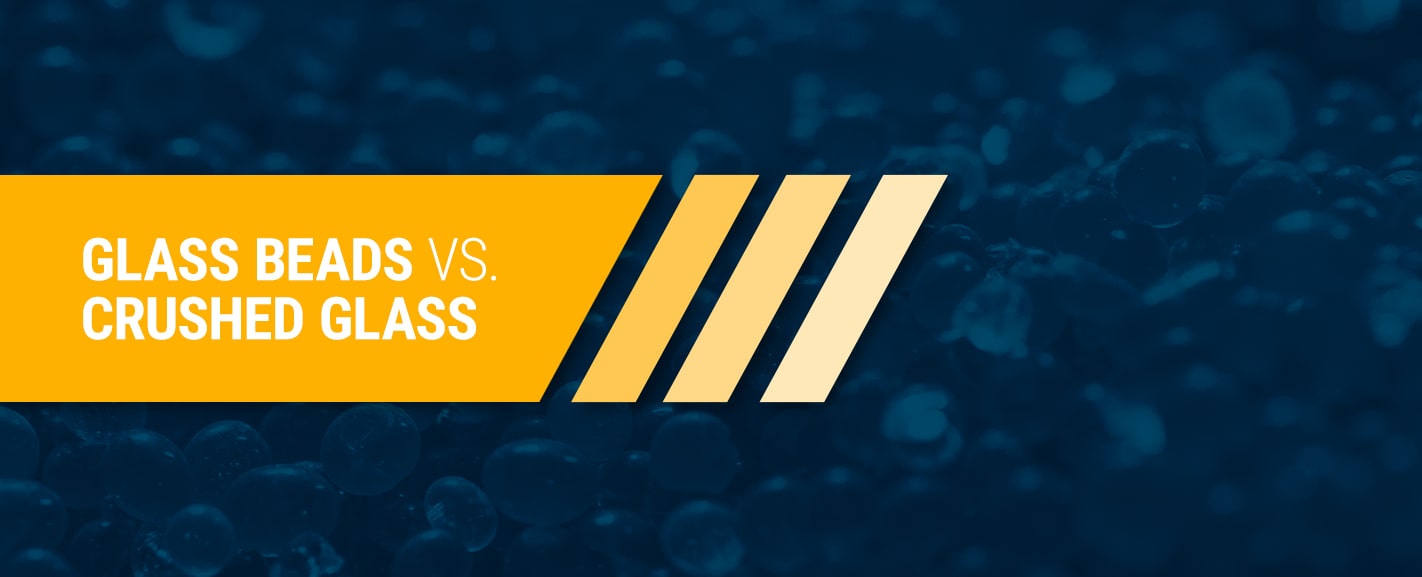Glass Beads vs. Crushed Glass

Choosing Between Glass Beads and Crushed Glass
Last Updated: October 17, 2023When it comes to achieving a desired finish on a surface, both glass beads and crushed glass are excellent abrasives. Glass beads are typically used in blast cabinets or reclaimable blast operations, providing a consistent bright matte finish on materials like aluminum and steel. Crushed glass, on the other hand, excels at removing heavy coatings, paint layers, or rust, leaving behind a clean and bare surface. Despite being made from the same base material, these two abrasives produce distinctly different end results.
If you're trying to decide which abrasive is best suited for your project, comparing glass beads and crushed glass is essential. Each has its own set of advantages and applications, so understanding their differences can help ensure you make the right choice for your needs.
For more information or assistance, feel free to contact us.
Applications for Glass Beads
Glass beads are ideal for finishing metals. They're versatile and can be used for tasks such as frosting and etching glass, among other common applications:
- Cleaning: Perfect for surface preparation without altering tolerances or introducing ferrous contaminants.
- Finishing: Different bead sizes offer a variety of unique surface finishes and help blend machining marks.
- Peening: Reduces tensile stress in metal components, enhancing fatigue limits.
- Deburring: Successfully removes burrs without damaging parts, resulting in a smooth peened surface.
One significant advantage of using glass beads is their eco-friendly nature, as they contain no free silica, a common concern in metal finishing. Traditional sandblasting media often includes free silica, which can release harmful substances during the abrasion process. Although some companies still opt for silica sand, stricter regulations are now in place due to the heightened risk of respiratory diseases among workers.
The size of the bead, the shape of your workpiece, the distance of the blast nozzle, air pressure, and the type of blasting system all influence the final finish and your abrasive consumption. If used correctly, glass beads can be recycled multiple times. When choosing glass bead blasting equipment, consider a sandblast cabinet to aid in recovering and reusing this blasting media effectively.
Glass beads are an efficient abrasive choice, helping you save both time and money. With shorter cycle times, you can process larger quantities of items more quickly. The wide range of bead sizes ensures you achieve the desired finish on your parts. Experienced suppliers of glass bead blasting media can assist you in selecting between coarser and finer beads based on your specific requirements.
No matter the type of glass bead you choose, they all contribute to a bright, smooth, and satin-like finish.
Applications for Crushed Glass
Due to its irregular crushed shape, crushed glass provides a stronger etch on your workpiece, making it suitable for surface preparations where subsequent coatings might be applied. Our crushed glass stands out in numerous applications thanks to its performance, health, and environmental benefits compared to other abrasives.
- 100% recycled glass can be reused many times and is environmentally friendly for disposal.
- It's non-toxic and chemically inert, reducing pollution risks and making it safe to use around water.
- Contains less than 1% free silica, compared to silica sand, which can contain up to 99% free silica.
- Our SDS does not list beryllium, a heavy or toxic metal commonly found in other abrasives.
- The natural, white post-blast finish creates an attractive final touch.
- Reduces embedment issues, which occur up to five times more frequently in slag blast media.
- Translucent, enhancing visibility and productivity during blasting operations.
- Less dense than other abrasives, reducing material usage and media costs.
- May be QPL or CARB approved depending on the plant.
- SSPC AB-1 Class A and MIL-A-22262B(SH) approved based on toxicological safety evaluations.
While both are used to finish metal surfaces, abrasive blasting and sandblasting are distinct processes, each advantageous in different scenarios and projects. Using glass beads for sandblasting is less conventional, but crushed glass blasting media can be used with a standard sandblast pot.
Grades and Profile Guide
Crushed glass is available in a variety of sizes, each producing different Mil finishes.
MEDIUM 1.0 – 2.5 MILS: Typical 2.3 MIL (SSPC-AB1 Grade 2)
Cleans and polishes surfaces for a smooth, white finish. Ideal for automotive, dustless blasting, and as a soda blast alternative.
MEDIUM – COARSE 2.5 – 3.5 MILS: Typical 3.1 MIL (SSPC-AB1 Grade 3)
Suitable for bridges, tanks, steel construction, and precast concrete.
COARSE 3.5 – 4.5 MILS: Typical 3.8 MIL (SSPC-AB1 Grade 4)
Ideal for bridges, tanks, steel construction, precast concrete, and when a deeper profile is needed.
Selecting Glass Abrasives from Finishing Systems
Finishing Systems is renowned as a leading supplier of glass beads and crushed glass. We offer comprehensive finishing solutions and products to businesses of all sizes for a broad spectrum of applications. Whether you need to strip paint or remove rust, our abrasive blasting equipment can deliver the results you desire while preserving the integrity of the material's surface.
To learn more about glass beads, crushed glass, or other abrasives, please reach out to us today!
Rotary Drilling Hose,Copper State Rotary Drilling Hose,Rotary Hose In Drilling Rig,Rotary Hose For Drilling Rig
Hebei no one but god energy equipment co.,ltd , https://www.p-harcourtbrothers.com